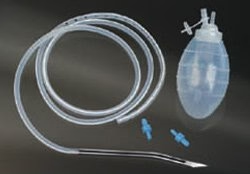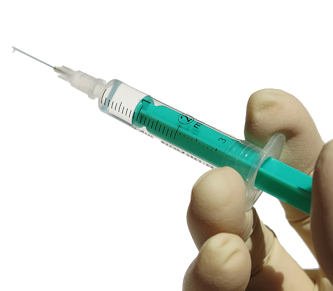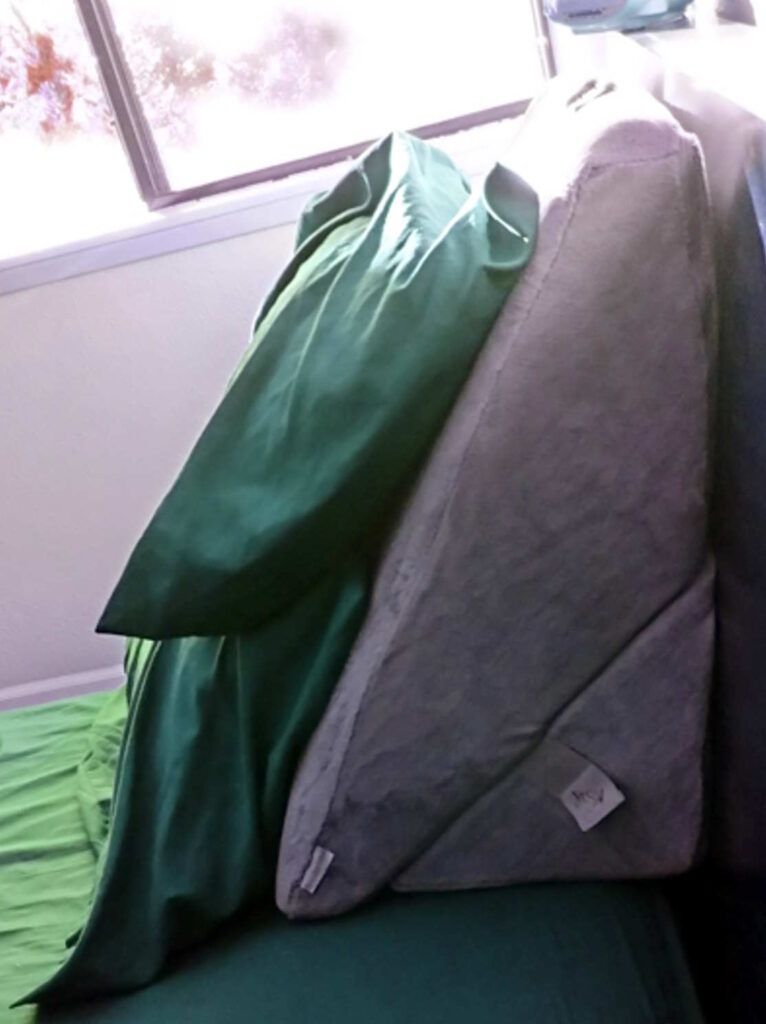Jump links within this page:
Links to more tummy tuck experience pages on this blog:
- Abdominoplasty (page 1 of 8)
- On the Inside (page 2 of 8)
- Life Happens (page 3 of 8)
- The Decision (page 4 of 8)
- Surgery (page 5 of 8)
- Initial Healing (this page)
- Recovery (page 7 of 8)
- The Final Touch (page 8 of 8)
The First Night

I was wheeled out of the hospital and transferred into the waiting car for an uneventful ride home mid-afternoon, just ahead of rush hour.
Having previously undergone abdominal surgery, I expected the first few weeks of recovery to be the most challenging. Simple transitions—from standing to sitting and vice versa, and from standing upright to lying down and vice versa—would be asynchronous, as though my abdomen stayed put while the rest of me moved. Then, after a brief lag, I’d feel the jarring tug of my abdomen trying to rejoin the rest of my body.
For some weeks, all abdominal straining was strictly prohibited. My doctor thoroughly prepped and coached me on the lifestyle adjustments I’d need to make in order to avoid any and all forms of pulling, pushing, and reaching. Lifting anything over 5 lbs. was out of the question, as was straining my bowels. This meant asking for help to open a sticky freezer door, abstaining from lifting and pouring from a gallon bottle, taking daily laxatives…you get the picture: Avoid straining at all costs.

Drawing from my past experiences, I extended the list of no-no’s to include: no coughing, sneezing, or belly-laughing. And yes, there are simple, thoughtful steps one can take to greatly minimize these surprisingly preventable bodily stresses. A patient’s commitment to set and abide by these limits is key to an accelerated recovery. By acknowledging this to be a time of deep vulnerability, one can graciously allow others to take charge. Accepting help is not always easy, but saying thank you is.
Walking is one of the few activities that poses no challenges to a person in this stage of recovery, but my bestie took no chances. I was helped out of the car and steadied by her arm as we headed toward the house and made a beeline for the living room.
My sofa had been converted into a cozy reclining/sleep space with all of my personal items prearranged to be within my reach. Instead of piling on the blankets, I kept a blow dryer at my side, activating it for extra heat, if needed. I got this idea at the hospital, where patients were hooked up to adjustable forced-air warming blankets that blew heat directly into their paper gowns. Beware, however, and consider that the blow dryer’s or forced-air blanket’s overuse can result in excessively dry skin.
Readiness
I still felt no pain. I was filled with profound gratitude, but braced for the aches to begin once the anesthesia wore off. Thankfully, that did not happen, and the pain never came. I was grateful to my bestie, and for the foresight, initiative, meticulous planning, and execution that transformed my home to accommodate my new needs. We talked about the evening’s plans and outlined my minimal responsibilities for the first 24 hours:

- Wear my abdominal compression garment continuously. This is to reduce swelling, prevent hernia formation, assist in skin retraction, speed up healing, and provide support and comfort.
- Wear compression socks and gently exercise my leg and foot muscles often. This helps prevent the formation of blood clots (deep vein thrombosis) and improve blood circulation.
- Keep an eye on the level of serous fluids accumulating in my globe, and seek assistance in emptying and logging the output. When fluid output wanes sufficiently (about 2 weeks’ time, give or take), my doctor would remove the tube.
- Preemptively control pain with medication and/or supplements. The idea is that, by effectively managing comfort levels, the risk of overindulging on potentially addictive opiates is reduced.
The bulk of the responsibilities of the first 24 hours fell on my bestie’s shoulders. Tasks included checking on/replacing my antibiotic cream and gauze, dispensing medications and supplements, providing food and hydration, and helping me to change. Her duties were compounding by her commitment to pet-sit all weekend. Traveling between two homes—dispensing needed assistance at both—effectively made it a working weekend for her. However, knowing the house was prepped and meals were cooked was reassuring. We felt confident I’d be in good hands with my daughter and her BF during her periods of absence.
She reminded me that she’d be back at 8 pm to administer my nightly shot—to which I replied “What shot?” I had conveniently forgotten about it, and was genuinely surprised. Although I wasn’t hungry then, I supposed I’d have an appetite by 8 pm, so I suggested she pick us up a couple of Lake Oswego’s best burgers for dinner.
My lack of an appetite was likely an outcome of the residual fullness from the surgical gases still in my abdomen. I burped these out—little by little—during the afternoon, and started to feel human again, with an awareness of my growing hunger.
A New, Temporary Normal
You wouldn’t believe how much work a helpless, uncomfortable person can generate. That afternoon and evening (in between frequent burps), I experienced alternating cycles of shivering cold, followed by intense heat. And oh, so itchy! I scratched relentlessly, taking care to avoid incisions and other sensitive areas. By the time my bestie returned, all of me required changing. I succeeded in removing my perspiration-drenched compression garment on my own. As showering and bathing were prohibited, I used wipes.

While I gave myself a wipe bath, my bed was stripped, Lysoled, and the sheets and blankets were replaced. All of my dressings required changing, so as I stood shivering and blow drying my body, my bestie reapplied the antibacterial ointment and fresh gauze. Fastening the two zippers of my clean compression garment was somewhat challenging, calling for our combined ingenuity. However, since that time, we figured out an effortless technique (described below) for donning the garment.
Next came the injection. I dread these even more than I do surgery, but my bestie handled herself like a pro, proficiently administering shots on 8 consecutive nights. It’s astonishing to me that a couple of on-the-fly conversations with Dr. Fichadia were sufficient for her to learn the procedure. She didn’t even need to practice on an orange!
After a delicious dinner in good company, and about a dozen more patient care activities, it was time to say good night. In my experience, acute discomfort that lasts a couple of days would hit within the first 24 hours. To ensure a comfortable sleep and an even better wake-up, I dutifully took an opiate. The following morning, as I took another one, I decided it would be my last. The pain I expected never came: not the previous night, and not at all. I switched to a prophylactic regimen of of Tylenol, which I continued for about 10 days before stopping all anti-inflammatory medications. I did, however, maintain use of anti-inflammatory and other supplements.
This surgery experience was exceptional. To my knowledge, the extent and variety of care techniques imparted by Dr. Fichadia far exceed and outshine traditional post-op care instructions. I attribute my remarkable level of well-being during my recovery to her guidance.
The First Weekend
Other than my good feeling and peace of mind, those first days were not particularly noteworthy. My bestie provided for me, kept me hydrated, brought me food, and dispensed meds and supplements per the schedule. My doctor and hospital each phoned to ensure I was doing well. I hardly gave a thought to my very, very gross surgical drain. With assistance, my bulb was regularly emptied, and serous fluids logged.
10 Recovery Life Hacks
We devised methods to simplify the management of my recovery process. The following hacks are arranged in the order implemented:
Reduce coffee intake: Suggesting that you quit coffee entirely is an unrealistic ask of many—probably the reason doctors seldom recommend it, in the first place. I enjoy coffee, but indulge only when I crave its distinct, cozy flavor, with no consistency. This irregular pattern has led me to observe that my systolic blood pressure rises by 20 points after drinking as little as a single cup, a finding echoed by acquaintances polled informally. Recognizing caffeine as the potent drug it is, I monitor its intake. In the past, my inconsistent coffee consumption habits have triggered unintended and extremely painful withdrawal symptoms. I’ve learned that, for me, foregoing coffee for a few consecutive days after a period of heavy consumption culminates in a prolonged headache, muscle aches, nausea, and a general inability to function until my body fully detoxes. To avoid these effects, I manage caffeine levels carefully, implementing increases or decreases gradually. This approach avoids abrupt disruptions and results in symptom-free quits. And since coffee is prohibited on the day of surgery, and not knowing how I’d feel after the procedure, I preemptively and gradually eliminated the beverage entirely the week beforehand.
A Step-by-Step Guide to Shot Administration

- Prepare the essentials: Unpack and remove cap from syringe, set aside. Unpack a sterilized cotton ball or gauze, two disposable gloves, and one alcohol wipe (or alternatively a cotton ball soaked in alcohol), set aside.
- Identify the injection site: Locate a fatty area on patient’s thigh by pinching flesh with thumb and forefinger. To indicate sufficient fattiness, look for a dimpling response.
- Clean and sterilize: Wash hands, dry with a paper towel, slip gloves on. Get an ice cube and rub target area to numb. Follow with an alcohol wipe to sterilize.
- Reconfirm injection site: Pinch flesh again. This tactile reconfirmation lifts the skin and subcutaneous tissue which, in turn, will minimize the sensation of what’s next.
- Administer the injection: With a swift, dart-like motion, insert the needle into the pinched skin at a 45-60° angle. Slowly plunge to deliver the medicine. Once the medication is fully administered, remove the syringe carefully and apply gentle pressure to the injection site with a sterilized cotton ball or gauze.

Sleep on a wedge: Surgical tightening leaves an abdominoplasty patient somewhat hunched over, for a time (about two months, in my case). And when you can’t stand straight, lying flat is also a challenge. Using a sleep wedge will help you achieve the dorsal recumbent position that’s recommended for recovery. For added comfort, I topped mine with a couple of small pillows.
Keep water within reach at all times: It is far easier to track daily water intake by filling a single 64 oz. container once, instead of 8 individual glasses.
Combine, combine, combine: When not contraindicated, combine medications with supplements. Combine all supplements needing dissolution into one beverage.
Shower (permitted 48 hours after surgery): Total immersion (e.g., bathing) is altogether prohibited. While showering, ensure that the flow of water is aimed at your back, away from incisions and impacted sites. If you use a hand-held showerhead, lower it from its perch before your procedure. Likewise, ensure all shower essentials are within reach—not too high or low. If space allows, dust off and place a plastic chair in your shower for added comfort.
Cut up old shirts: Properly attaching the bulb (the far end of the surgical drain) high up on my person caused one side of my shirt to pull and flip up, making me feel cold and lopsided. To resolve this issue, we cut a vertical slit from the bottom left side of an old cotton shirt. The slit accommodated the drain that came up from that side, all the while ensuring I remained adequately covered.
Wear compression garment externally: Despite being designed as an undergarment made of the highest quality fabric, I didn’t want the compression garment to touch my skin directly and always wore a long shirt (albeit one with a vertical slit) under it.
Keep it (the compression garment) zipped for easier re-zipping: Before removing the garment (e.g., to use the rest room), leave one zipper completely closed, unzip 3/4 of the second zipper, then slip out of the garment. To put it back on, completely zip up one zipper, as well as the bottom 2″ (5 cm) of the second zipper. Then slide into the garment as though you’re pulling on a pair of very tight jeans. (Anyone remember Sergio Valente, Gloria Vanderbilt and Calvin Klein?) Zip up once the garment’s in place. Caveat: Because we developed this process over time, I cannot confirm its suitability for the first days of recovery.
Enjoy a lymphatic massage (permitted 2+ weeks after surgery): This consists of very light pressure combined with soft pumping movements. Given that the treatment involves easily replicated light touches on accessible target areas, it can be learned and performed by the patient herself, or obtained through a licensed massage therapist or chiropractor.
Schedule
We typed up a medication and supplement schedule that was far easier to follow than deciphering individual bottle labels:
Evenings
- Enoxaparin, an anticoagulant injection to the thigh to prevent blood clots (thrombosis)
- Refill 64 ounces of water to drink throughout the next day
- Reminder: B R E A T H E
- Reminder: Pump ankles and legs to avoid blood clots
- Nuun sports hydration drink: Have as many of these as you want. Drop 1 tablet into 16 oz. water, wait few minutes for tablet to dissolve
- Tylenol (in glass container): 2 caplets every 6 hours
- Arnica Montana (in Chapstick-looking case): 5 pellets, 3x/day
Mornings
- Reminder: B R E A T H E
- Reminder: Pump ankles and legs to avoid blood clots
- Seed pre- and pro-biotics (in heavy brown jar w/pineapple label): 2 on an empty stomach
- Nuun sports hydration drink:* Have as many of these as you want. Drop 1 tablet into 16 oz. water, wait few minutes for tablet to dissolve
- Juven by Ensure:* Mix 1 packet with 8-10 ounces of water, stir – 2x/day
- Tylenol (in glass container): 2 caplets every 6 hours
- Arnica Montana (in Chapstick-looking case: 5 pellets, 3x/day
- Senna: 2 tablets, 1x/day
- MiraLAX:* 1 beverage, 1x/day
Afternoons
- Nuun sports hydration drink: Have as many of these as you want. Drop 1 tablet into 16 oz. water, wait few minutes for tablet to dissolve
- Juven by Ensure: Mix 1 packet with 8-10 ounces of water, stir – 2x/day
- Tylenol (in glass container): 2 caplets every 6 hours
- Arnica Montana (in Chapstick-looking case): 5 pellets, 3x/day
___________________
* For efficiency, combine Juven, Nuun, and MiraLAX into a single beverage.
As Needed/Order of Operations for Changing
- Undress (and if needed: have bed sheets changed at this time, remove old gauze and tape)
- Clean body with wipes
- Empty and log serous fluid output
- Reapply dressings
- Put on a top
- Pre-zip compression garment (see above) before slipping it on
- Shimmy in flank pads
- Zip garment up all the way
- Pin bulb to garment
